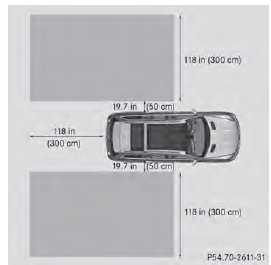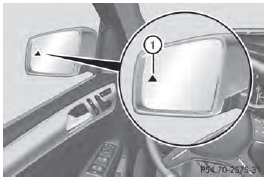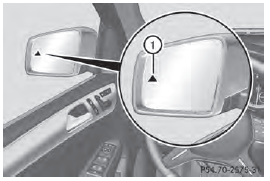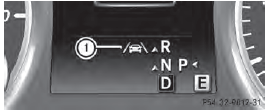Lane Tracking package
General notes
The Lane Tracking package consists of Blind Spot Assist and Lane Keeping Assist .
Blind Spot Assist
Important safety notes
WARNING
Blind Spot Assist does not react to: • vehicles overtaken too closely on the side, placing them in the blind spot area • vehicles approaching and driving by with a speed difference of more than approximately 6.8 mph (11 km/h) As a result, Blind Spot Assist may not give warnings in such situations. There is a risk of an accident.
Always observe the traffic conditions carefully, and maintain a safe lateral distance.
Blind Spot Assist is only an aid. It may fail to detect some vehicles and is no substitute for attentive driving.
USA only:
This device has been approved by the FCC
as a "Vehicular Radar System". The radar
sensor is intended for use in an automotive
radar system only. Removing, tampering
with, or altering the device will void any
warranties, and is not permitted by the
FCC. Do not tamper with, alter, or use in
any non-approved way.
Any unauthorized modification to this device could void the user’s authority to operate the equipment.
General notes
Blind Spot Assist uses a radar sensor system to monitor the areas on both sides of your vehicle. It supports you from a speed of approximately 20 mph (30 km/h). A warning display in the exterior mirrors draws your attention to vehicles detected in the monitored area. If you then switch on the corresponding turn signal to change lanes, you will also receive a visual and audible collision warning. Blind Spot Assist uses sensors in the rear bumper for monitoring purposes.
For Blind Spot Assist to assist you when driving, the radar sensor system must be: • activated • operational
Monitoring range of the sensors
In particular, the detection of obstacles can
be impaired if:
• dirt on the sensors or anything else
covering the sensors
• poor visibility, e.g. due to fog, heavy rain,
snow or spray
• narrow vehicles, e.g. motorcycles or
bicycles
• the road has very wide lanes
• the road has narrow lanes
• you are not driving in the middle of the lane
R there are barriers or similar lane borders
Vehicles in the monitoring range are then not
indicated.

Blind Spot Assist monitors the area up to 10 ft (3m) behind your vehicle and directly next to your vehicle, as shown in the diagram.
If the lanes are narrow, vehicles driving in the lane beyond the lane next to your vehicle may be indicated, especially if the vehicles are not driving in the middle of their lane. This may be the case if there are vehicles driving at the inner edge of their lanes.
Due to the nature of the system: • warnings may be issued in error when driving close to crash barriers or similar solid lane borders.
• the warning is canceled when driving for an extended period next to long vehicles, such as trucks.
The two radar sensors for Blind Spot Assist are integrated into the sides of the rear bumper. Make sure that the bumper is free of dirt, ice or slush in the vicinity of the sensors.
The sensors must not be covered, for example by cycle racks or overhanging loads.
Following a severe impact or in the event of damage to the bumpers, have the condition of the radar sensors checked at a qualified specialist workshop. Blind Spot Assist may otherwise not work properly.
Indicator and warning display
Blind Spot Assist is not active at speeds below approximately 20 mph (30 km/h). Vehicles in the monitoring range are then not indicated.

1 Yellow indicator lamp/red warning lamp When Blind Spot Assist is activated, indicator lamp 1 in the exterior mirrors lights up yellow at speeds of up to 20 mph (30 km/h).
At speeds above 20 mph (30 km/h) the indicator lamp goes out and Blind Spot Assist is operational.
If a vehicle is detected within the monitoring range of Blind Spot Assist at speeds above 20 mph (30km/h), warning lamp 1 on the corresponding side lights up red. This warning is always emitted when a vehicle enters the blind spot monitoring range from behind or from the side. When you overtake a vehicle, the warning only occurs if the difference in speed is less than 7 mph (12km/h).
The yellow indicator lamp goes out if reverse gear is engaged. In this event, Blind Spot Assist is no longer active.
The brightness of the indicator/warning lamps is adjusted automatically according to the ambient light.
Collision warning
If a vehicle is detected in the monitoring range of Blind Spot Assist and you switch on the corresponding turn signal, a double warning tone sounds. Red warning lamp 1 flashes. If the turn signal remains on, vehicles detected are indicated by the flashing of red warning lamp 1. There are no further warning tones.
Switching on Blind Spot Assist

■ Make sure that the radar sensor system and Blind Spot Assist are activated in the on-board computer.
■ Turn the SmartKey to position 2 in the ignition lock.
Warning lamps 1 in the exterior mirrors light up red for approximately 1.5 seconds and then turn yellow.
Towing a trailer
When you attach a trailer, make sure you have correctly established the electrical connection. This can be accomplished by checking the trailer lighting. In this event, Blind Spot Assist is deactivated. The indicator lamp in the exterior mirrors lights up yellow, and the Blind Spot Assist Currently Unavailable See Operator's Manual message appears in the multifunction display.
You can deactivate the indicator lamps in the exterior mirrors.
To do so, switch off Blind Spot Assist when:
• the SmartKey is in position 2 in the
ignition lock
• the engine is not running
• the electrical connection to the trailer
has been established
Lane Keeping Assist
Important safety notes
WARNING
Lane Keeping Assist may not always clearly recognize lane markings.
In this case, Lane Keeping Assist may: • give an unnecessary warning • not give a warning There is a risk of an accident.
Always pay particular attention to the traffic situation and stay in lane, in particular if warned by Lane Keeping Assist.
WARNING
The Lane Keeping Assist warning does not return the vehicle to the original lane. There is a risk of an accident.
You should always steer, brake or accelerate yourself, in particular if warned by Lane Keeping Assist.
If you fail to adapt your driving style, Lane Keeping Assist can neither reduce the risk of an accident nor override the laws of physics.
Lane Keeping Assist cannot take into account the road, traffic and weather conditions. Lane Keeping Assist is merely an aid. You are responsible for the distance to the vehicle in front, for vehicle speed, for braking in good time and for staying in your lane.
The Lane Keeping Assist does not keep the vehicle in the lane.
The system may be impaired or may not
function if:
• there is poor visibility, e.g. due to
insufficient illumination of the road, or due
to snow, rain, fog or spray
• there is glare, e.g. from oncoming traffic,
the sun or reflections (e.g. when the road
surface is wet)
• the windshield is dirty, fogged up, damaged
or covered, for instance by a sticker, in the
vicinity of the camera
• there are no, several or unclear lane
markings for a lane, e.g. in areas with road
construction work
• the lane markings are worn away, dark or
covered up, e.g. by dirt or snow
• the distance to the vehicle in front is too
small and the lane markings thus cannot be
detected
• the lane markings change quickly, e.g.
lanes branch off, cross one another or
merge
• the road is narrow and winding
• there are strong shadows cast on the lane
General notes
Lane Keeping Assist monitors the area in front of your vehicle by means of a camera at the top of the windshield. Lane Keeping Assist detects lane markings on the road and warns you before you leave your lane unintentionally.

1 Lane Keeping Assist camera
If you select km on the on-board computer in the Display Unit Speed-/Odometer function , Lane Keeping Assist is active starting at a speed of 60 km/h. If the miles display unit is selected, the assistance range begins at 40 mph.
A warning may be given if a front wheel passes over a lane marking. It will warn you by means of intermittent vibration in the steering wheel for up to 1.5 seconds.
Switching on Lane Keeping Assist

■ Switch on Active Lane Keeping Assist using the on-board computer; to do so, select Standard or Adaptive .
Symbol : appears in the multifunction display.
If you drive at speeds above 40 mph (60 km/h) and lane markings are detected, symbol 1 is shown in green. Lane Keeping Assist is ready for use.
Standard
If Standard is selected, no warning vibration
occurs if:
• you switch on the turn signals. In this event,
the warnings are suppressed for a certain
period of time.
• a driving safety system intervenes, such as ABS, BAS or ESP®.
Adaptive
If Adaptive is selected, no warning vibration
occurs if:
• you switch on the turn signals. In this event,
the warnings are suppressed for a certain
period of time.
• a driving safety system intervenes, e.g.
ABS, BAS or ESP®.
• you accelerate hard, e.g. kickdown.
• you brake hard.
• you steer actively, e.g. swerve to avoid an obstacle or change lanes quickly.
• you cut the corner on a sharp bend.
In order that you are warned only when necessary and in good time if you cross the lane marking, the system recognizes certain conditions and warns you accordingly.
The warning vibration occurs earlier if: • you approach the outer lane marking on a bend.
• the road has very wide lanes, e.g. a highway.
• the system recognizes solid lane markings.
The warning vibration occurs later if: • the road has narrow lanes.
• you cut the corner on a bend.
See also:
Setting the temperature
Dual-zone automatic climate control
Different temperatures can be set for the
driver's and front-passenger sides.
■ Turn the SmartKey to position 2 in
the ignition lock .
■ To i ...
Important safety notes
WARNING
Objects in the driver's footwell can restrict the
pedal travel or obstruct a depressed pedal.
The operating and road safety of the vehicle
is jeopardized. There is a risk of an accident. ...
Off-road driving systems
4MATIC (permanent four-wheel drive)
If you fail to adapt your driving style, 4MATIC
can neither reduce the risk of accident nor
override the laws of physics. 4MATIC cannot
take account of road, we ...
